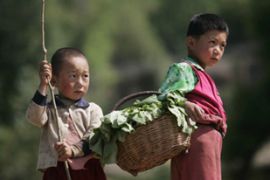Alarm raised over child labour
At least 22,000 children die each year in agriculture-related incidents.

The Rome-based agency said that out of the 218 million children who work in the world, 70 per cent are working in agriculture – which includes forestry, fisheries, and agricultural and livestock management.
Eve Crowley, from the FAO’s gender, equity and rural employment division, said that 22,000 children die each year in agriculture-related incidents.
“Children are given dangerous tools and machinery that aren’t appropriate for their age. In forestry, they climb tall trees to harvest palm wine or fruits where they can fall.
“They carry heavy loads which are too much for their small bodies to handle and they are also exposed to dangerous chemical products, be they pesticides or fertilisers, without the proper protective equipment.
|
“The simple truth is that children require fewer guarantees, are far easier to exploit and, most of all, are considerably cheaper” Jose Maria Sumpsi, FAO assistant director-general for agriculture and consumer protection |
In Cameroon, child labour is cheap labour in cocoa plantations. Children collect and carry heavy loads of cocoa pods that harm the development of their bones, joints and muscles.
In Cameroon, Ghana, Nigeria and the Ivory Coast more than 150,000 children in 2002 were involved in the handling and application of pesticides on cocoa plantations.
“Children, biologically, are different to adults – their skin structure, their breathing speed, for example,” Crowley said.
“All of these things have a huge impact on them. It can permanently affect their mental and physical well-being, and cause permanent handicaps in some cases.”
Regular exposure to organic dust puts children at greater risk of developing allergic respiratory diseases, such as asthma.
Florina, 13, had to work with her mother on a farm in Romania
She says: “I’m afraid of the tractor. When I feel it is getting closer my heart beats fast.
“And that dust… When the tractor comes, it brings up all the dust from the wheat. If you inhale the dust, you can cough all day.”
Florina’s mother says: “If the girl stays with me all day, then I earn around $8, but if she doesn’t, I only get $7. I can’t do all the work by myself, my husband is sick. There is no other solution than for her to continue coming to work with me.”
Poverty
Sumpsi says the key to combating child labour is to reduce poverty.
| The statistics |
|
About 318 million children under 18 work in some form of economic activity An estimated 218 million children are in work defined as child labour And 216 million child labourers are engaged in hazardous activities More than 150 million children (70 per cent) work in agriculture Of those, 22,000 children die each year in agriculture-related incidents Agriculture ranks as one of the three most dangerous work activities, along with mining and construction
|
“The true winning strategy against child labour is to reduce poverty in rural areas of the developing world, offering income opportunities, addressing health and safety in agriculture, improving pesticide management, and ensuring sustainable development,”he says.
“Child labour is also driven by unscrupulous employers who claim that children’s nimble fingers are better for picking certain crops and a lack of schools in rural areas.
“But studies by the ILO [International Labour Organisation] in hazardous industries like glass production or diamond polishing have shown this not to be the case.
“In agriculture, as in other sectors, there is no work that an adult cannot do equally well, if not better, than a child.
“The simple truth is that children require fewer guarantees, are far easier to exploit and, most of all, are considerably cheaper.”
Investing in children
Noé Silvestre Carneiro, president of the rural workers’ union in Retirolandia, Brazil, said: “The situation for working children in this region is extremely dangerous.
“We have children who have been blinded because thorns from the sisal leaves went into their eyes. We have children who have lost a hand in the shredding machine.
 |
| The ILO has set a target to eliminate child agricultural labour by 2016 [EPA] |
“They work without any protective clothing. So the unions are very concerned. We are all committed … to rescue the children from the exploitation, to put them into good schools so that they can have a better future.”
When asked about the possibility of the eradication of child labour, Crowley said: “The elimination of child labour is definitely a major challenge.
“The ILO has set a target for itself to achieve this by 2016, and we’re happy to say that on June 12, FAO, ILO, IFAD and a whole number of organisations have joined together to sign a declaration of intent to work together to achieve this target.”